Update on US GOM: Methane Hydrates
Posted by Luis de Sousa on July 17, 2009 - 10:14am in The Oil Drum: Europe
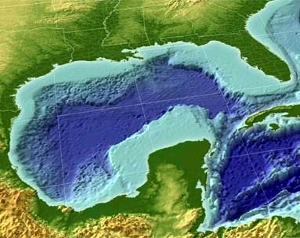 This is a guest post by Jean Laherrère, the second of a series on the current knowledge of the deepwater Oil and Gas reserve at the Gulf of Mexico. In this second installment Jean analyses the Methane Hydrate resource of the region, in face of recent claims of great drilling results in the region.
This is a guest post by Jean Laherrère, the second of a series on the current knowledge of the deepwater Oil and Gas reserve at the Gulf of Mexico. In this second installment Jean analyses the Methane Hydrate resource of the region, in face of recent claims of great drilling results in the region.
The first article of the series, on the conventional Oil and Gas reserve, can be found here. Thanks to ace's diligence an error was identified and corrected, resulting in an update to the graph on Commulative Oil and Gas Discovery over 400 meters deep.
Last year I wrote a paper on worldwide hydrates: Hydrates updated, published by The Oil Drum on April 17, 2008. But since then, a survey on hydrates was carried out in the Gulf of Mexico (GOM). Seven deepwater slim holes were drilled last April as part of Leg II of the Joint Industry Project (JIP Leg II). The results were claimed by Dr Collett to be "very encouraging":
Our drilling at Walker Ridge block 313 and Green Canyon block 955 has discovered the most promising marine gas hydrate accumulations in the world […]
What's unique about the Gulf of Mexico accumulations identified is this. It's the first time we've seen highly concentrated hydrates in conventional sand reservoirs that could be commercially producible,[...]
Let’s see on what the basis for this claim is.
Oil and gas fields reserves need well samples and production tests to calibrate all the other measurements. In particular porosity and permeability, estimated from well logs, need to be calibrated with cores.
To be brief: no core, no reserve estimate.
After my previous paper, one of the comments was that it does not matter that hydrates weren't recovered in the core, because they are very unstable and disappear. So hydrates should be in the ground, even if not recovered in the corer! The pressure corer is supposed to fix the problem and exactly that was used in the GOM JIP. Furthermore, it is surprising to see that in other places like at Lake Baikal it is very easy to recover hydrates (see TOD 3819). Why is GOM hydrate so hard to recover if present everywhere?
All hydrate programmes mention the need for coring:
For marine hydrates, there is a need for multi-well drilling expeditions in the Gulf of Mexico, with coring and logging (similar to the 2006 Indian hydrate expedition) to characterize hydrate deposits and to validate emerging exploration technologies. (p. 6)
Key Elements of an Accelerated Hydrate R&D Program. . . 1. Fund the Chevron Gulf of Mexico JIP for a multi-well transect with full logging and coring programs for Spring 2008. (p. 14)
Key Cross-cutting Programmatic and Procedural Milestones:
4.1.17 FY2007: Finalize design and conduct field tests of new pressure coring tools (DOE (Chevron JIP)). (p. 23)Current Program Portfolio: Chevron Gulf of Mexico Joint Industry Project with research partners ConocoPhillips, U.S. Geological Survey, Minerals Management Service, Total, Schlumberger, Rice U., Georgia Institute of Technology, Reliance Industries, JOGMEC, and Scripps Oceanographic Institute. Phases 1 and 2 resulted in the 2005 drilling, logging, coring of two sites in the Gulf of Mexico to investigate safety aspects of hydrates in fine-grained sediments. Phase 3 (currently in planning) will pursue improved pressure coring tools, evaluate locations for gas hydrates within coarse-grained (sand) sediments, conduct initial drilling and LWD evaluation of those sites (4Q2007) and conduct follow-on drilling and coring operations (FY2008/2009). (p. 35)
Above quotes from Report to Congress: An Assessment of the Methane Hydrate Research Program and An Assessment of the 5-Year Research Plan of the Department of Energy [pdf!], June 2007
Pressure core analysis has become the keystone that links these data sets together and is an essential component of modern gas hydrate investigations […]
Schultheis et al , Pressure core analysis: the keystone of a gas hydrate investigation [pdf!], International Conference on Gas Hydrates, 2008, Vancouver.
The main objective of the JIP cruise was to collect sediments cores and a full suite of logs on seismically well-characterized sediments that show evidence for occurrence of gas hydrates. Although the petroleum industry has operated in the Gulf for decades, relatively little information has been collected on the nature of the shallow sediments, and seismic records and well logs have not been calibrated for the interpretation of gas hydrates.
In JIP GOM gas hydrate coring update [pdf!] G.Claypool NETL Fire in ice, Summer 2005.
Gas hydrate saturation cubes such as those shown in Figures 17 and 18 must be calibrated. It should be noted that, despite the large number of drilled hydrate wells worldwide, quality hydrate logging and coring data are scarce, especially in the Gulf of Mexico. Such data are urgently needed. Until we devote resources to undertake such logging, coring, and laboratory measurements, current estimates of possible gas that can be obtained from gas hydrates must be questioned.
Dai et al , Detection and estimation of gas hydrates using rock physics and seismic inversion: Examples from the northern deepwater Gulf of Mexico [pdf!], The Leading Edge, Jan.2004.
Phase III of the project is to collect data on hydrate bearing sands. Both logging and coring operations are planned. Phase III of the project began in September of 2007 and will focus on obtaining logs and cores of hydrate bearing sands in the GOM […]
In Characterizing Natural Gas Hydrates in the Deep Water Gulf of Mexico: Applications for Safe Exploration and Production Activities [pd!] Semi-Annual Progress Report #41330R16, October 2008 – March 2009.
But there was no coring in JIP leg II, completed last month, only well logs within slim holes were obtained (lack of funds, lack of suitable rig?)! There is no explanation for the absence of cores, especially since it was in the planning!
Coring is now planned for 2011
Phase 3A is currently ongoing. Site selection and detailed scientific and operational planning for the drilling/logging expedition have been completed. The expedition was initiated on 3/16/09 and sites involved are to include Green Canyon 955, Walker Ridge 313 and East Breaks 992 (contingency sites include Green Canyon 781/825 and Alaminos Canyon 21/65). The multi-location, multi-hole program will include a full suite of well logs and will provide vital information related to occurrence of hydrate in coarse grained sediment in the Gulf of Mexico, will help prove out the prospecting methodologies used in the selection of targeted sites and will lay the ground work for Phase 3B coring expedition.
Phase 3B will involve the planning and carrying out of a separate hydrate coring cruise (anticipated in 2011), the follow on analyses, interpretation and dissemination of information generated from project activities.
From The National Methane Hydrates R&D Program webpage.
We have to wait until 2011 to know more about the GOM hydrate potential!
What are the hydrate in-place resource estimates?
In its 2000 report Oceanic gas hydrate research and activity review [pdf!] (MMS 2000-017), the MMS claimed (Kvenvolden 1993) that the distribution of worldwide organic carbon in gas hydrate (onshore and offshore = 10 000 Pg) was twice the amount of fossil fuels (coal, oil and natural gas = 5 000 Pg). This figure was still being used by the USGS in 2006 (Collett et al). This was unrealistic because most hydrates are located in the first 600 m of recent oceanic sediments (water depth > 500 m) which covers a period of time of a few millions years, while fossil fuels sediments cover a period of about one billion years, with larger surface and thickness (>6000 m).
In his book "The Deep, Hot Biosphere" Thomas Gold in July of 1992 (which convinced the Swedish government to drill two wells on the Siljan meteorite crater looking for abiogenic oil and gas. He justified his theory by the large volume of oceanic hydrates:
The large quantities of methane hydrates (methane-water ices) found in many areas of the ocean floor, and thought to contain more methane than all other known methane deposits, suggest a widely distributed methane supply from below.
There is no convincing occurrence of abiogenic oil anywhere and this explains the failure of Gold’s theory, based on hugely wrong hydrate estimates. However, if oil is a complex product needing organic matter to be generated in Nature, methane is a simple molecule and can be generated from chemical reactions involving mantle rocks (it is, for instance, found in space), explaining the desire of Gold to find abundant methane in the Earth's mantle.
But Alexei Milkov (the most respected hydrate expert with experience from Russia and US hydrate surveys) shows a graph (present in my previous hydrates article) which shows that hydrates estimate have been in decline since 1973. The estimated quantity has fallen by a factor of more than 1000, with the resulting volume now similar to that of conventional gas, but without any technique to produce them.
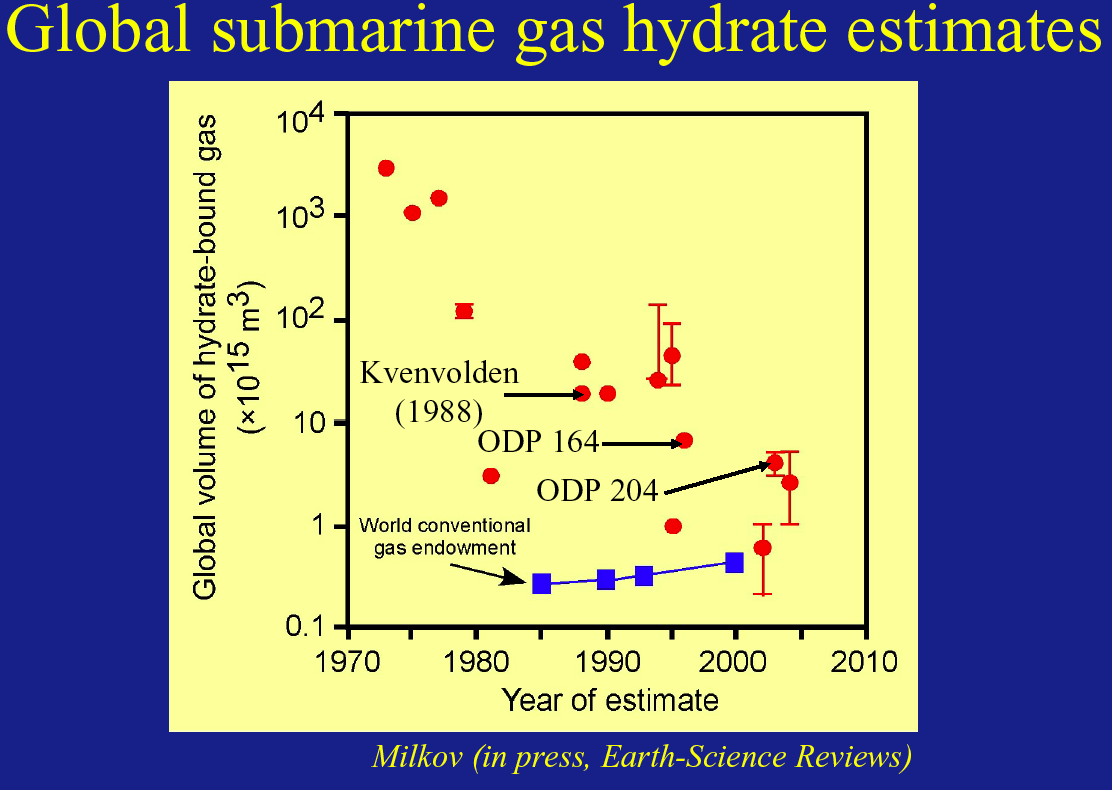 |
Milkov estimates hydrates to be between 500 and 2500 Gt, to compare with 10 000 Gt by Kvenvolden in 1988 (which is unrealistic, looking at the geological time involved for hydrates compared to fossil fuels).
 |
If the quantity of hydrates is 500 Gt, the quantity of hydrates is lower than that of geopressured dissolved methane, which 30 years ago was described (50 000 Tcf in the Gulf Coast) as the energy of future (as hydrates are now described by some, in particular in the IPCC's SRES scenarios). But pilot production projects of geopressured dissolved methane were commercial failures, unable to handle pollution problems.
This unrealistically huge estimate is still found in a 2008 Canadian report on hydrates:
Recent estimates suggest that the worldwide volume of gas trapped in hydrate accumulations is in the range of 1 to 120 x 1015 m3 (35,000 to 4,200,000 trillion cubic feet, Tcf). The French version is 35 000 to 4 200 0000 billions de pieds cubes, because for the SI of units (which is the official rule in Canada but also for the US Federal agencies since 1993) billion is square million or 10E12 cf or Tcf, T being tera and not trillion (trillion in SI is cube million = 10E18 or exa)
In Energy from gas hydrates: assessing the opportunities & challenges for Canada The Expert Panel on Gas Hydrates [pdf!], Council of Canadian Academies, 2008-11-05 .
This shows that billion (or trillion) should not be used in papers outside the US, but only symbols as M for mega, G for giga, T for tera, E for exa or 10E3, 10E6, 10E9, 10E12. The SI rule is also not to use the comma for thousands but a space, because in some countries the comma is used as the decimal separator.
With very few drilling and coring data sets available, a reliable estimate of global volume of natural gas hydrate appears to be elusive. It is also difficult to assess the quantity of gas hydrate present on a given margin because of the heterogeneous sedimentological environments along each margin deposits varied significantly, even within tens of metres (Riedel et al., Proceedings of the IODP, 2006). Extrapolation from the local scale can be unreliable without additional knowledge of the scale of heterogeneity.
MMS 2000-017 indicated that:
In the Gulf of Mexico, drill core samples are especially needed to characterize gas hydrate deposit locations and behaviors before any kind of production is attempted
[...]
Gas hydrate extraction may become a reality as soon as 2015
[...]
« In 1995, the USGS completed its most detailled assessment of US gas hydrate resources. The USGS study estimated the in-place gas resource within the gas hydrates of the US to range from 112 000 Tcf to 376 000 Tcf, with a mean value of 320 000 Tcf. Subsequent refinements of the data in 1997 using information from the Ocean Drilling Program have suggested that the mean should be slightly downward, to around 200 000 Tcf.
In a later report, entitled Preliminary Evaluation of In-Place Gas Hydrate Resources: Gulf of Mexico Outer Continental Shelf [pdf!] (MMS 2008-004) the estimate (through Monte Carlo runs) of gas hydrate in-place was a 95% chance of 11 112 Tcf and a 5% chance of 34 423 Tcf (in fact the text confuses T trillion (or Tera) and thousand):
For instance, there is a 95-percent chance that at least 11,112 thousand cubic feet (TCF) of gas hydrate are in place in the GOM, and a 5-percent chance that more than 34,423 TCF are in place.
The probabilistic distribution of in-place gas-hydrates resources for the GOM is given as below; it is obviously the result of a Monte Carlo run (usually tens of thousands) which transforms a very simple guess into something looking like a looking real data plot!
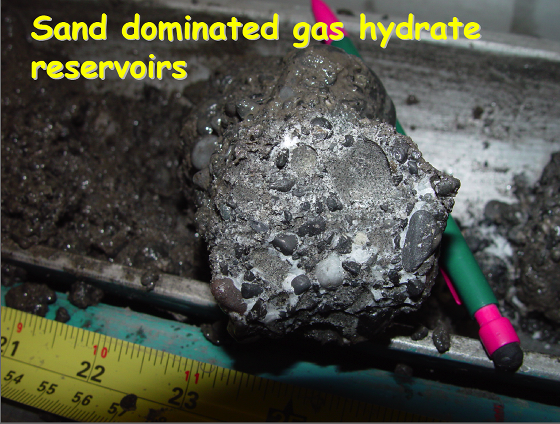 |
But as indicated before, most of these estimates have been carried out guessing the occurrence of hydrates without the backing of core data.
Where are the cores showing oceanic hydrates?
It is very difficult to recover hydrate in cores, because hydrate melts with the change in temperature and pressure when they are brought to surface. It is necessary to keep the pressure within the core. Different core equipments were built since this problem occurred when JOIDES drilling began (it was a main concern when I was a member of the JOIDES Safety Panel in the 1970s). Each new survey tests a new equipment (pressure corer like HYACE, HYACINTH, Fugro,..) and concludes that better equipment or a new survey is needed.
The first industrial hydrate survey in Nankai Japan in 1999 did not recover any hydrate in the recovered cores and JNOC decided to get some hydrate core from permafrost sediments in Canada (logged since 1972 as Mallik 2) to know more on hydrate behaviour. But permafrost hydrate accumulations in Mallik (or Messoyakha in Russia) are completely different from oceanic hydrates, being gas fields in good sandy reservoirs trapped before the glaciation (about 2 million years ago). These shallow reservoirs are now within the hydrate stability zone (deeper reservoirs are just conventional natural gas).
From Collett et al 2006 in permafrost (Alaska) :
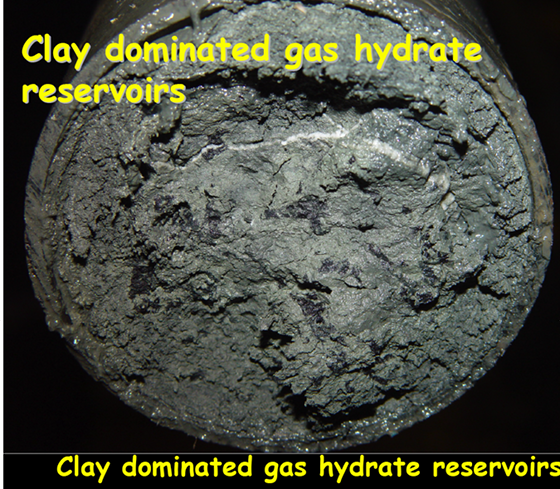 |
Instead, oceanic hydrates occur in clay sediments where gas was converted into hydrate, being unable to migrate, for the pressure and temperature keeps it in the solid state. Only gravity can eventually move the hydrate, because it is lighter than water.
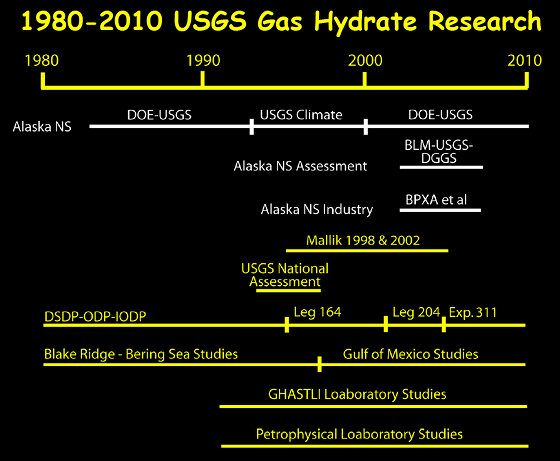 |
The USGS is active in the US hydrate programme. From Collett et al 2006:
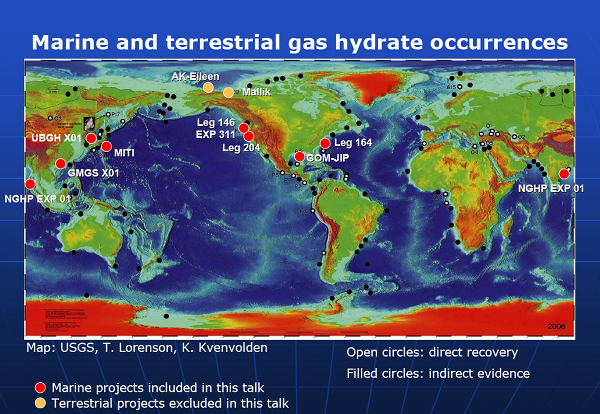 |
Ten years later, Japan conducted two drilling surveys in 2001 and 2004, amounting to six months drilling with a JOIDES resolution ship. This time they finally did core some hydrate, but very little geological information is published and no picture of these cores can be found on the Internet. According to a presentation delivered by Abe at IIASA in March of 2008, the estimate for the hydrate reserves in Nankai is 20 Tcf (with 40 Tcf for resources). But production experiments are planned only for 2012 and 2014 (METI, AIST & JOGMEC). For a country in great need of domestic energy, hydrate is either not a priority, or they feel that the potential for domestic hydrate production is weak!
The oil industry knows hydrates well because they are a nuisance: plugging pipes and production tubing are vulnerable to hazards caused by hydrates when drilling in deepwater. The MMS requires in the Application for Permit to Drill an evaluation of the hazards of hydrates in order to avoid them.
In 2001 a JIP group was formed, led by Chevron, to investigate the problems of hydrates in the GOM within the oil industry. JIP includes Chevron, ConocoPhillips, Halliburton, JOGMREC (Japan), MMS, Reliance, Schlumberger, Total, KNOC (S. Korea) and StatoilHydro (who joined recently). In 2005 the JIP Leg I drilled 7 wells on AT 13/14 and KC 151 in the course of 35 days (Ruppell et al 2008) with a dynamic positioning semi-sub that recovered 19 cores (total length 6 m):
The JIP launched a 35-day expedition in Spring 2005 to acquire well logs and sediment cores at sites in Atwater Valley lease blocks 13/14 and Keathley Canyon lease block 151 in the northern Gulf of Mexico minibasin province. No gas hydrate was recovered at the drill sites, but logging data, and to some extent cores, suggest the occurrence of gas hydrate in inferred coarser-grained beds and fractures, particularly between 220 and 330 m below the seafloor at the Keathley Canyon site. The expedition did not recover visible gas hydrate during any of the coring operations, nor was gas hydrate directly imaged in pressure cores that were subjected to X-ray analyses (Claypool, 2006) .
C. Ruppel, R. Boswell, E. Jones Scientific results from Gulf of Mexico Gas Hydrates Joint Industry Project Leg 1 drilling: Introduction and overview Marine and Petroleum Geology 25 (2008) 819–829
In my 2008 review I indicated that because of finding of no hydrate in the 2005 cores, the oil industry concluded that hydrates pose a minimum-drilling hazard.
The seismic section of leg 164 is shown with 3 sites: 994, 995 and 997. The so called BSR (Bottom Simulating Reflector) was absent on site 994 and present in sites 995 and 997, but the log on these three holes was similar to the hydrate zone. It is now well established that BSR depends on the gas below the hydrate stability zone, before a small concentration of fizzy water (lemonade) drastically changes the velocity of the sediments. BRS has nothing to do with hydrate concentration, even though this was assumed in most of the resource estimates.
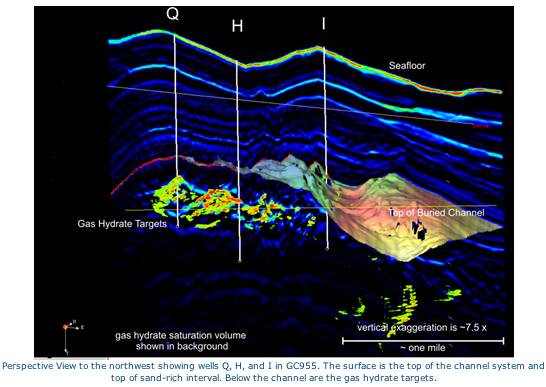 |
In Leg II three wells were drilled in Green Canyon 955 between the April 22 and April 28, 2009. The first well encountered more than 300 ft of porous sands as predicted; however, these sands contained primarily water – with only modest indications of gas hydrate:
The JIP's discovery of thick gas hydrate-bearing sands at GC955 validates the integrated geological and geophysical approach used in the pre-drill site selection, and provides increased confidence in assessment of gas hydrate volumes in the Gulf of Mexico. It is expected that further evaluation of the complex geology of these sites, including both fracture-filling and pore-filling gas hydrate in numerous fault blocks (with potentially varying geochemical conditions and gas hydrate/free gas configurations) will add significantly to the understanding of the nature and occurrence of gas hydrate-saturated sands in the marine environment [...]
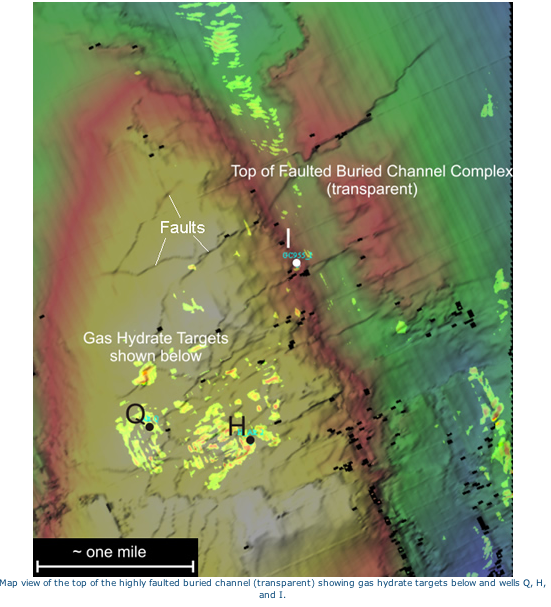 |
The so-called hydrate target looks dispersed and of limited horizontal extent (100 m!). It was written that:
Phase III of the project is to collect data on hydrate bearing sands. Both logging and coring operations are planned. Phase III of the project began in September of 2007 and will focus on obtaining logs and cores of hydrate bearing sands in the GOM [...]
Coring is indicated in the planning of the several selected locations, but it was not carried out in Leg II, without any explanation.
Phase 3A is currently ongoing. Site selection and detailed scientific and operational planning for the drilling/logging expedition have been completed. The expedition was initiated on 3/16/09 and sites involved are to include Green Canyon 955, Walker Ridge 313 and East Breaks 992 (contingency sites include Green Canyon 781/825 and Alaminos Canyon 21/65). The multi-location, multi-hole program will include a full suite of well logs and will provide vital information related to occurrence of hydrate in coarse grained sediment in the Gulf of Mexico, will help prove out the prospecting methodologies used in the selection of targeted sites and will lay the ground work for Phase 3B coring expedition. Phase 3B will involve the planning and carrying out of a separate hydrate coring cruise (anticipated in 2011), the follow on analyses, interpretation and dissemination of information generated from project activities.
From The National Methane Hydrates R&D Program webpage.
Alaska
The USGS estimates hydrate resources in the North Slope in the range of 25 Tcf to 157 Tcf, with a mean of 85,4 Tcf. This mean was 590 Tcf in the 1995 estimate, (quite a drop!) but they claim that back then it was in-place whereas now it is technically recoverable gas.
Two hydrates wells were drilled and cored in the last 5 years:
Hot Ice 1
In 2003 & 2004 a well was drilled by Anadarko with the goal to recover hydrate, because its name was clear: Hot Ice. It was cored for more than 200 ft and no hydrate was found, neither in the core or in the logs!
During the winter operations seasons of 2003 and 2004, Anadarko Petroleum in cooperation with Maurer Technology and Noble Corporation and with the partial support of DOE drilled and cored a shallow well, Hot Ice 1, located at 30-T9N-R8E, Umiat Meridian, on the North Slope of Alaska.
The Hot Ice 1 well was drilled from the surface to 2300 ft. There was almost 100% core recovery from the bottom of surface casing at 107 ft to TD at 2300 feet measured depth from the surface. Based on the best estimate of the bottom of the methane hydrate stability zone core was recovered over its complete range. Approximately 565 ft of good sandstone reservoir rock was recovered in the Ugnu formation and approximately 215 ft were recovered in the West Sak. There were gas shows in the bottom part of the Ugnu and throughout the West Sak. No hydrate baring zones were identified either in the recovered core or on the well logs.
Signal et al, Characterization of potential hydrate bearing reservoirs in the Ugnu and West Sak formations of Alaska’s North Slope.
Milne Point BP 2007 Mt Elbert gas hydrate project
500 ft of continuous core were recovered in 2007 with the stratigraphic well "Mount Elbert"; logs indicate 30 m (in two layers) of gas-hydrate saturated, fine grained, sand reservoir. But the only picture that I found shows grey sediment (they mention ice cementation with gas saturation of 45 to 75%) different from the typical white spots oceanic hydrate. Tests were conducted recovering methane (thermogenic and microbial gas).
Investigation of gas hydrate-bearing sandstone reservoirs at the "Mount Elbert" stratigraphic test well [pdf!], Milne Point Alaska, R. Boswell ICGH 2008 Vancouver
There is a video showing the gas dissociation of the Mt Elbert at the NETL webpage (direct link to mpeg file here).
There is obviously methane release from these cores, like it happens with marshy gases or with cow flatulence (1 m3/d). 50% of green house gases (GHG) emissions in New Zealand come from cows and sheep. This figure is only 14% in Australia, where kangaroos do not emit any methane because of a special bacteria in their guts (they are trying to move it to cows and sheep!). A long production test is needed to know more about Mt Elbert's potential, but that it is not yet decided!
Production
A Permafrost hydrate in sandy sediments is quite different from an oceanic hydrate in clay, mostly unconsolidated sediments. Permafrost hydrates were drilled in oil and gas producing basins: they are old accumulations and mainly thermogenic. Oceanic hydrates were drilled in oil and gas producing basins (e.g. GOM). In the North Slope hydrates seem quite uneconomical (the Mallik test was less than a CBM test) and their interest is negligible when Prudhoe Bay free gas reserves are still stranded (in unconventional production the size of the tank does not matter, it is the size of the tap!). It is a far future prospect, needing first a gas pipeline and much higher gas prices because of the small flow (no pressure because shallow depths). Collett et Petrotech 2009 (Geologic and engineering controls on the energy resource potential of gas hydrates [pdf!]) states that the maximum rate on Mallik 2008 was 4000 m3/d .
There is no production concept for oceanic hydrates, because no one knows how to extract them, if they mainly lie in unconsolidated impermeable sediments. Furthermore, the heterogeneity of oceanic hydrates (few centimetres vertically and few meters horizontally) seems to be a difficult obstacle to overcome.
Conclusions
Hydrate is the Santa Claus of many who do not want to change their way of life. But hydrate occurrences are hard to evaluate, mainly because of a lack of samples (cores), which is the only way to calibrate all the visible proxies: well logs and seismic data.
The GOM is now claimed to have the "most promising marine gas hydrate accumulations in the world", but unfortunately this is only wishful thinking without the coring, which is now planned only for 2011 or later. As usual, the data is incomplete to back up such optimistic claims, in particular for the GOM.



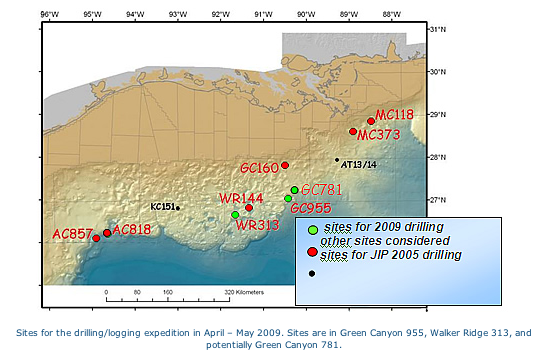
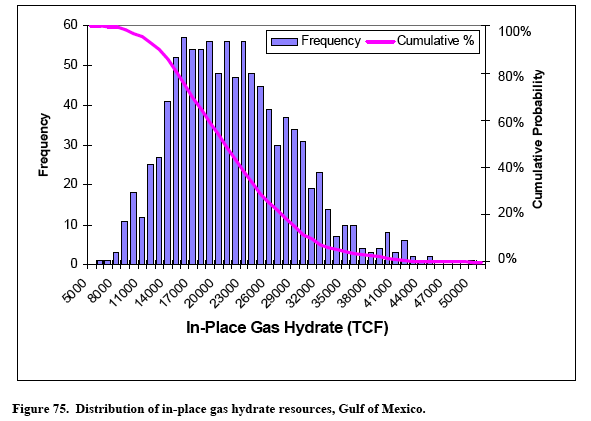
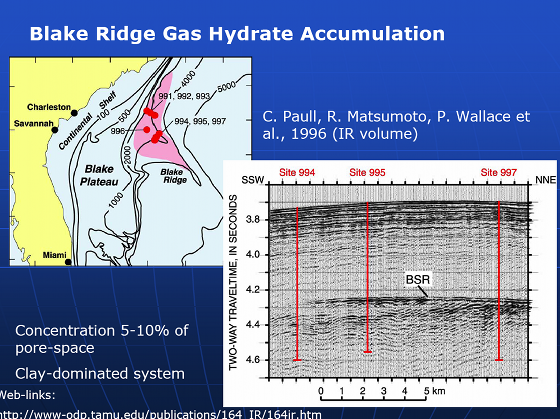
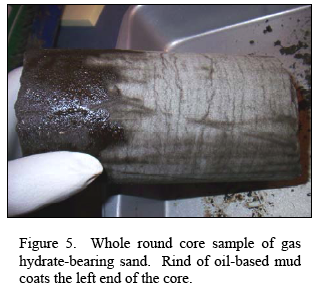

Methan Hydrates seem to be the boogy man of the anthrophmorphic climate change brigade. Wikipedia has a good article on them. It's somewhat reassuring that there is somewhat less of them than was initially thought but even so we are probably goign to end up cooked if they all go up.
Needs some serious research money spent. Strikes me that this is a energy source we should be trying to capture - even if it is not economically sensible. Burning off Methane would reduce the level of greenhouse heating, (Methane is a much more effective greenhouse gas then CO2).
According to Wikipedia "To date, there has only been one field commercially produced where some of the gas is thought to have been from methane clathrates, Messoyakha Gas Field, supplying the nearby Russian city of Norilsk."
How cound a carbon tax be used to encourage the capture of these gases?
Andrew: Methan Hydrates seem to be the boogy man of the anthrophmorphic climate change brigade.
I'd say the permafrost carbon store is a much bigger worry. Recent estimates of its mass are over 1 teraton, and Arctic permafrost is melting rapidly. Over a very short time, this melt could release gigatons of carbon that have been sequestered for millions of years.
Sadly, I couldn't agree more strongly. I've been following the permafrost issue pretty closely over on The Cost of Energy (which is where the links below all point), and the news isn't comforting.
There was a recent study that concluded that there's twice as much carbon in permafrost as previously estimated, a total of about 1.5 trillion tons. (See Permafrost = permafrost * 2)
As I posted just today (Methane checkpoint), the level of methane in the atmosphere continues to rise after having plateaued, approximately, for a few years. It's far too early to claim this is the permafrost bomb going off, but whatever the source I wish that extra methane would stop appearing in the numbers.
Defrosting permafrost (nolongerfrost?) is being cited as one possible explanation for the recent finding that only about half of the PETM warming 55 million years ago can be explained by atmospheric CO2 levels. (See Permafrost’s shadow)
Warning! Speculation follows: I think we're just now figuring out what an enormous influence the permafrost can have on climate. E.g. it grows thick with biomass in warm periods, lowering CO2 and therefore temperature, until it freezes year round. When something else jostle the system (orbital perturbations, whatever), then just a little warming (like our current 0.8C over preindustrial times) is enough to start defrosting it during summers, which quickly leads to a massive feedback and warming.
If it turns out we've triggered that kind of feedback, something we won't know for at least a few more years, then we're in more trouble than we can imagine.
Your "speculation" is actually pretty well supported by everything I've read on the subject. Peter Ward's "Under a Green Sky" is quite good on these paleoclimate issues.
Basically it turns out that direct AGW, bad as it's direct consequences are already, turns out to be a minor concern compared to the multiple feedbacks it has/is/will be setting off, multiplying it's effects many times.
Some monitoring stations in the far north are showing some of the most dramatic rises in non-C13 (=non-abiotic) methane, suggesting that tundra melt/clathrate release is now contributing significantly to atmospheric methane.
The significance of methyl clathrates (aka methane hydrates, fire ice, etc) for climate destabilization is not IMO about their banks' total scale so much as their propensity to collapse and release CH4 under minor changes.
This is because the planetary carbon sinks, whose intake has varied annually between about 1.4 and 3.2 GTC, may be swamped (offset) by a miniscule fraction of the global Hydrates stock, particularly given the >22-fold greater warming influence of CH4 than CO2.
For a round number baseline, the sinks' annual removal of 2.0 GTC would mean sequestering about : 2.0 x 11/3 = 7.33 GT CO2,
whose removed warming impact would be replaced by just : 7.33 / '22' = 0.33 GT CH4,
whose actual Carbon content would in turn be a mere :0.33 x 3/4 = 0.248 GTC.
Thus the Hydrates' release in one year of 0.248 GTC in the form of CH4 could definitively overwhelm the planet's carbon sinks, launching the catastrophic 'runaway' greenhouse, whereupon any and all cuts in anthro GHG output would no longer be effective.
Given estimates of 1,500 GTC in permafrost, and another 500 to 3,000 in the seabed Hydrates, 0.248 GTC release per year as CH4 is a tiny fraction to pose such an existential threat.
The Hydrate banks' actual volume is thus largely irrelavent : what matters is their instability at the margins of their most vulnerable areas.
And that includes vulnerability to disturbance by commercial exploitation.
Regards,
Backstop
It's much worse than that, actually. The 22xCO2eq number you cite is for 100 year time frame. But most of the methane remains in the atmosphere for a few years, this number is misleading. I've seen figures over 70 times CO2 for decade periods, and over 100 times for seven year periods (the point at which fifty percent of the methane remains in the atmosphere, as I recall).
So pick your figure. It's not going to take a huge portion of the clathrates to be disturbed or melted to overwhelm sinks. keep in mind that much of the clathrate that has been studied in the Arctic Ocean is in a state where a very small increase in temperature will turn it to gas, and much is in quite shallow waters only a few meters deep along the continental shelf.
Poking around in this stuff to get a short term profit/energy boost strikes me as colossal and suicidal idiocy, even by modern industrial capitalism's very low standards of idiocy.
In certain respects, one would suspect that the in-place volume of methane hydrates swamps the more "pure" grades of methane. See the chart put out by the DOE a while ago:
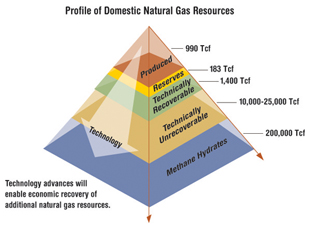
http://www.theoildrum.com/node/3287
This is a characteristic of most types of ores, as the grade of the resource diminishes, the more of it you have. In general and somewhat intuitive terms this is explainable by the fact that the march of entropy will disperse and mix the material in ever finer compositions over the span of time. And that gravity and diffusion allows the solute to migrate to varying-size pockets, creates this huge range in densities and volumes.
What constitutes recoverable is the big question. The fact that as Laherrere states that much of the hydrates occur as a thin film along the deep ocean floor or permafrost essentially puts the kibosh on practical recovery.
Methane, simple CH4, yet so enigmatic. Mars, anyone?
Somewhere I have read that crater like depressions varying in size up to maybe a kilometer across have been found on the sea floor that may be the result of hydrate deposits breaking loose and floating away perhaps as a result of a nearby earthquake,etc.
Is this "for real"?
And for the engineers:If all this new gas we hear about,both onshore and off,is really producible at a reasonable cost:
About how much ,percentage wise of a given quantity of gas,is needed to convert the remainder into liquid fuel or propane,which is a practical fuel for heavy trucks and farm tractors,etc?
And in present day dollars,very roughly how much would such fuel or propane cost,above and beyond the cost of the gas used to manufacture it?
Hydrate deposits are notoriously unstable. Especially on the continental shelf-edge slopes down towards the deep ocean, 'land slips'
can occur, releasing large amounts of hydrate which floats to the surface, 'melts' and forms a huge methane burp. These have been
observed and are thought to be one possible cause for unexplained ship disappearances in the Bermuda triangle and elsewhere. The
methane bubbles reduce the effective density of the water and the ship sinks like a stone, completely without warning.
Bermuda Trianglization of Society. Maybe we can disappear as species and not leave a trace. Now there is a black swan.
We will leave plenty of traces: a mass extinction episode, toxic & radioactive waste dumps, a depleted stratospheric ozone stratum, an atmosphere replete with oxidized carbon & other high heat capacity gasses, and an acidified ocean, to name but a few of the major "traces" we will leave behind.
we may have been reading from some of the same sources.is there any solid evidence that you know of to support the lost ships scenario?
Re: conversion to liquid fuels, it depends a lot on what the composition of the gas is. It's easier to do when there is a high fraction of ethane, propane, etc.
My students did a design exercise this year trying to work out the number for the OXCO (oxidative coupling process) outlined by Edwards et. al. (Edwards, J.H., Do, K.T. and Tyler, R.J., FUEL 71(3), 1992, pp325-334).
Using a natural gas that was about 90% methane and only a couple of percent heavier hydrocarbons, with some semi-wild guesses about energy consumption in different parts of the plant, they got overall conversion efficiencies of about a third to a half. ie, about half to two thirds of the gas was discarded as oxidised process waste or required to fuel a gas turbine to provide electricity for the plant.
Xuewen,
Thanks,I've posted this question before.Yours is the first response.
The unconventional domestic gas appears to be there,and it appears that it can be had at a fairly reasonable price,according to others who comment here regularly.
Maybe the clathrates will work out too.
Now if somebody who knows about these rhings will supply a rough estimate of the cost and capacity of a conversion plant,I could make an informed guess at the price of liquid motor fuel a few years down the road.
I've been waiting for this post for a while, but the
tone is skeptical and dismissive of what appears to be solid research.
A portion of the natural gas since the 1980s at Mesoyakha has been produced from gas hydrates in Western Siberia(25 Gcf/a(feeding the remote Norilsk nickle mines), and it seems likely that giant Yamal gas field(770 Tcf) is fed by gas hydrates. In the future it is likely most of Europe's gas will come from gas hydrate fed fields in Siberia.
http://www.gsj.go.jp/dMG/dMGold/hydrate/production.gif
http://en.wikipedia.org/wiki/Messoyakha_Gas_Field
http://old.gazprom.ru/eng/articles/article32739.shtml
So gas hydrates are REAL.
A surveyed patch I read somewhere was 50 foot thick and covered 500 acres amounting to +100 billion cubic feet(at 100 cfh/cuft.).
If you look over the material at doe, netl, the foreign governments and the big participation by the energy companies like Chevron it doesn't look like at all like bullshit (such as abiotic gas as insinuated by the post).
Gas hydrates look pretty damn real, IMO.
Maybe a really good gas well might produce 40 mcf/d which is the energy equivalent to a not-so-good
oil well producing 6300 barrel per day . The truth is natural gas is not as energy intensive or
economically desirable as oil. This is the reason why a big natural gas pipeline out of Alaska may not be built but oil pipelines do get built: gas is simply not as 'sexy' as petroleum.
However it is a very inconveniently located resource, so we are back to a 'size of the tap' argument and this new source will have to compete with all the old sources which we are gobbling up.
Natural gas can be water shifted to hydrogen, a carbon free source of energy if the resulting CO2 is captured and sequestered.
Basically, a TOTAL phase out of carbon could be accomplished.
There would be so much gas that IC engines could be converted to run on hydrogen gas.
Given new global requirements for a low carbon future(80% GHG reduction by 2050), now would seem an opportune time to move decisively to phase out oil then move on to hydrogen as a fuel for cars, etc.
But lower energy density natural gas must be given preference over oil.
Leave the clathrates alone. Attempting to exploit them may destabilize them. They aren't an economically viable energy source anyway. They may play a geophysical or ecological role we don't understand.
You are drowning and someone throws you a rope but you don't reach for it for fear of dragging them in.
You're right--the world would be better off if you were dead.
Seems you don't understand we are in a climate crisis AND an energy crisis, both which methane hydrates can address in a major way.
"God helps those who help themselves"--Ben Franklin
Ok, "you" are drowning...and NOBODY throws you a rope. That's where you are today. Methane Hydrates are NOT a rope that will rescue you. Power down.....do the world a favor. It's our only hope.
Respectfully, we are in neither a climate or energy crisis. We are in a human crisis, trying desperately to support far too many beyond a sustainable level, with a huge effort to support an extraordinary standard of living and continue business as usual and return to perpetual growth. We are frantically grasping at straws in an attempt to sustain the un-sustainable. Just because potential resources may be available to prolong our over-consuming life styles a little bit longer, does that mean we must exploit them? At some point in the future we must power down and learn to be content with less.How do we benefit by prolonging the day of reckoning?
You may well be too intelligent, informed, & wise for this forum e. j. ;)
"At some point in the future we must power down and learn to be content with less."
Hey, a lot of Europeans, Japanese and Americans could do with less and still be living better than the richest lived only a few centuries ago...but "less" will be a hard sell in the third and developing world for millions of people who have never known "enough", much less "more".
RC
"the world would be better off if you were dead."
Too much coffee this morning, maj?
...and the devil take the hindmost:
http://pulitzerphotos.wordpress.com/2008/09/06/baby-stalked-by-vulture-i...
Majorian, I really don't see how methane hydrates can help fight against climate change. They can only generate more methane or more CO2 in the atmosphere.
About fighting future energy crises by means of methane hydrates (I'm afraid it's too late to fight the present crisis this way), let's see. Why not research the matter? It is true that using methane hydrates as an energy source could become just a medicine to "prolong the agony", or it could provide some additional time to find alternative solutions. But we should never be afraid of researching.
At least give him a bit of credit, he was taking about capturing & sequestering the methane-hydrate derived CO2. I don't know how hard it is to capture, but apparently methane hydrates are eager to convert into CO2 hydrates, if you pump CO2 into them. That might be a way to obtain carbon neutral energy. Of course there is a major devil in the details. Can we produce from the hydrates? Can we economically capture the CO2 from the carbon in the methane? Can we reasonably and safely dispose of it? But, at least that was what he was proposing.
If we could do that, it would be a good thing, as these hydrates -if they are abundant enough, constitute a potential global warming time bomb. Neutralizing them ought to be a good thing.
Well,
methane hydrates produce methane(natural gas). Burning 1 million BTUs of natural gas for energy produces 117 pounds of CO2.
Burning 1 million BTUs of oil for energy produces 160 pounds of CO2.
Burning 1 million BTUs of bituminous coal for energy will produce 205# of CO2.
Take the US for example;
we burn 22000 million million BTUs of coal
plus
40000 million million BTUs of oil
plus
23000 million million BTUs of natural gas
for energy.
This totals
117/2000 x 23E9 + 160/2000 x 40E9 + 205/2000 x 22E9=
6,800,500,000 tons of CO2.
If all our energy came from natural gas,
117/2000 x (23 + 40 + 22)E9 = 4,972,500,000 tons of CO2.
our CO2 from energy would be reduced by 27%.
The next step would be to convert the natural gas to hydrogen gas(as we do making fertilizer) and burying the resulting CO2 emitting 0% CO2 to the atmosphere.
But you will surely object,
Why bother do anything?
Just stop using energy!
This is like saying the way to stop a famine is for everyone to starve to death.
I'd save that bit of cleverness for Plan B, if solutions like methane hydrates somehow don't materialize. In fact, by not acting we are heading for Plan B.
You are ignoring the energy cost of the conversion to hydrogen.
Actually, it's largely irrelevant, but here are my figures.
CH4 + H2O -->CO + 3H2: Reformating methane
Yes, there is a penalty in converting natural gas to hydrogen and then also sequestering the CO2(you forgot to mention).
The thermal conversion of natural gas to hydrogen is 65% efficient.
The energy required to capture CO2 from natural gas
is about 300 kwh per ton.
http://sequestration.mit.edu/pdf/David_and_Herzog.pdf
A CCS NG power plant would need 6.3 cubic feet of gas to produce 1 kwh of electricity and would produce .37 kg of CO2 per kwh for sequestration.
So 1 million tons of hydrogen would take 200 billion cubic feet of natural gas
1E6 x 126000/65% = 194 Gcf ~200 Gcf for 1 million tons of hydrogen
which would produce 10.6 million tons of CO2
which would require 4.0 Twh of electric power from a NG CCS power plant,
which in turn would require an additional 25 billion cubic feet of natural gas
bringing it up to 225 Gcf for 1 million tons of hydrogen.
The US uses 120 billion gallons of gasoline which is the energy equivalent of 120 million tons of hydrogen.
Multiplying by 120, we get an additional NG demand of 27 Tcf (120 x 225E9= 27 Tcf or 27 quads)
for zero emission hydrogen reformated from gas hydrate.
The US gas infrastructure transmits 23 Tcf per year now.
By efficiency this would beat petroleum as we currently use 29 quads of oil for transport versus
27 quads of hydrogen described above.
http://www.eia.doe.gov/basics/energybasics101.html
If TENS OF THOUSANDS of Tcfs of gas hydrates are available,
then this seems like a no-brainer with 50 Tcf per year of demand, lasting CENTURIES.
Less energy used 27 Tcf (NG to H2) < 29 Tcf oil.
Greater ultimate resource than oil.
ZERO CO2-emissions.
QED
"This is like saying the way to stop a
famineobesity epidemic is for everyone tostarve to deathgo on a diet."There, fixed that for you. ;-)
Similarly, BAU is like saying the way to avoid a hangover is to never sober up.
Majorian, it is true that methane generates less CO2 per unit energy than coal or oil. Substituting coal or oil by methane hydrates could perhaps reduce the amount of CO2 if we forget about how much energy is required to convert methane hydrates in the bottom of the ocean into usable fuel.
The problem is that methane hydrates would not substitute oil. We (the world) will burn the same total amount of oil with methane hydrates or without them. How much oil is that? It is ALL the extractable oil beneath the ground.
Thus, more methane hydrates, more CO2.
T
No.
Methane hydrates are drilled like coalbed methane gas wells which about 10% of US natural gas is drilled like that now.
http://newenergyandfuel.com/http:/newenergyandfuel/com/2008/04/23/a-brea...
It's true that we would need long pipelines and lots of wells but recent unconventional gas production has risen greatly with the new technology, so
the energy penalty must not be too bad.
I repeat--the idea would be to turn methane into hydrogen and bury the CO2, so no CO2 emitted.
There's no reason you couldn't convert your car to hydrogen gas,
or buy the BMW Hydrogen 7.
http://www.youtube.com/watch?v=Ykl2PH2B-tM&feature=related
I'm intrigued by the sheer range and depth of your wishful thinking with regard to utilizing Methyl Clathrates.
Despite the present lack of commercial scale exploitation, despite >50 years drillers' experience of clathrates, you blithely assume that issues both of practicality and of commercial viability will be overcome - in an era of destabilizing climatic conditions and of ever tightening finance services.
You then blithely assume that the methane produced will be carbon free as a/. it won't be burnt in any vehicles before its carbon's removal, and b/. CCS will again overcome both its insuperable practical difficulties, as well as the massive energy & financial costs, of the sheer scale of global CO2 flues' output needing to be captured, compressed, piped untold distances and then pumped into geology whose impermeability is beyond question.
Yet to me the most curious of your opinions is that you do not view the critical risk of disturbing clathrate formations as being worth even discussing. As has been made clear in posts on this thread, even a minute fraction of a conservative seabed clathrate reserve would be sufficient, without any other feedback loop's interaction, to initiate the catastrophic self-fuelling greenhouse effect.
All of which you choose to ignore.
Which seems to me a degree of irresponsibility way beyond dumbness, particularly given the plausible structure of your posts.
So could you please divulge to us just what your interest is that drives such a dubious fervour on behalf of Methyl Clathrates' exploitation ?
Regards,
Backstop
It looks as if we will disturb them either way-burning then is probably less hazardous than simply freeing them up by means of the green house effect.
This of course gets into the realm of geo-engineering, which brings up a number of practical and moral problems (moral hazard not the least).
Because some will likely be/are now being disturbed does not imply that we should go out disturbing more.
"Those wasps are almost sure to bite me eventually, so I might as well start hitting their nest now to kill as many as I can." Given our level of ignorance about these deposits, that may be about the right analogy for your approach.
Which gets us back around to the unintended geo-engineering project already well underway: dig up all the buried carbon and burn it as fast as we can. And let the hydrates do whatever it is they will naturally do with a 5°C temperature rise.
In the last 150 years we have released 50% of all the carbon naturally sequestered as oil over the last billion years or so. The geo-engineering experiment can't be stopped or reversed. It's going to play out to its conclusion, whatever that might be. Anyone who assumes business as usual is going to be grossly wrong. The only question is where are we headed, something our species is not terribly adept at determining with any degree of accuracy based upon historical analysis of past guesses.
Counter-earth, on the opposite side of the sun, is exactly like Earth except that it has no people on it. Counter-earth serves as the control for this geo-engineering experiment we are preforming. Alas that it isn't a larger sample size than this.
Always the mental block that restrains us from including expanded & extended railway network. Whatever the energy source in discussion, brains seem wired to perpetuating the private vehicle for everyone at puberty.
Roads, maintained to "minimum service levels" as Kunstler puts it, must also be part of any rubber tire transport energy calculation.
For convenience, please note information in Christopher C. Swan's "ELECTRIC WATER". A balance of transport inventory requires railway footprint and equipment/plant be increased with all due haste. Recommissioned Army/National Guard Railroad Operations & Maintenance Battalions is appropriate for underpinning railway program. See peakoil.net articles 374 & 1037
"Second Dimension Surface Transport Logistics Platform"
The link in the above text, "here", gives me a permission denied error when trying to access it. Scanning back through prior articles published on TOD:Europe, I can find no publicly listed node numbered 5482.
The link, both in your comment and up above, work for me. The title of the article is "Update on US GOM from MMS, EIA and Scout Data".
I know that some employers cut off access of The Oil Drum: Europe (which is where this post is located). I don't know if this is an issue. This is a link to the non-European version. Does it work any better?
I have checked that link from both my office and from home, two completely separate ISPs. Both give the same result - Permission Denied. I can access other TOD Europe articles just fine, again from either site. I cannot access node 5482. Can you tell me what page of the TOD front page node 5482 is linked from? I don't see it there either, and I've gone back several pages.
Gail, you are on staff with TOD and have different permissions. Has that article undergone a permission change, especially since the edits related to data uncovered by Ace?
Like Greyzone, I cannot access node 5482 either [everything else appears fine]. I tried both links: the original hyperlink 'here' and also Gail's provided US-based link.
node 5482 gives access denied to me also. (message posted to aid in debugging)
Fiery Ice
Some say the world will end in fire,
Some say in ice.
From what I've tasted of desire
I hold with those who favor fire.
But if it ends through human greed
I think the pow'r of melted farts -
appropriate to match our creed
and lack of smarts -
just might succeed.
I wonder if those who predict Peak Coal within a generation have models good enough to predict self sustaining methane release. That is when man-made CO2 eases off CH4 takes over. Apart from the warming at the start of the Eocene I believe the planet Venus was thought to have gotten hot and stayed hot due to methane.
I also heard that there is also fugitive methane release in the mining of some coal. It's hidden in the cracks and cavities or vesicles. If I recall digging 1000 kg of coal releases maybe 15 kg of methane equivalent to 300 kg of CO2. Methane could be the perfect assassin because familiarity breeds contempt.
Methane Hydrates should be developed. This would be a great addition to the energy production mix.
Oh and in case no one has heard, there isn't any "Global Warming".
http://www.nashuatelegraph.com/apps/pbcs.dll/article?AID=/20090717/OPINI...
Conservationist is correct. They should be developed by micro-miniature ant people that we can send down in tiny bathyspheres, and who then can colonize the ocean floor and create a nation as great as ours.
On the plus side, our ant-people brethren won't have to worry about sea-level rise due to global warming cuz they will already be underwater.
(story continued on page 14)
Actually, sea levels haven't been rising for few years now:
http://sealevel.colorado.edu/current/sl_noib_ns_global.pdf
Must be from the "Global Cooling".
And a, it's not the ant people we have to worry about(it's the ants).
http://news.bbc.co.uk/earth/hi/earth_news/newsid_8127000/8127519.stm
WTF? Are you looking at that graph properly? The trend line clearly indicates a rise in sea level. There is even a caption to that effect: 3.2 mm +/- 0.4 per year.
The graph "clearly" shows there hasn't been any sea level increase for the past 3 years, contrary to what the IPCC has stated. CO2 levels have increased during this period.
that's using a 60 day smoothing, try a 3 year moving average.
I think conservationist just pulled the Chewbacca Defense tactic on us.
Global seawater temperatures are rising.
http://www.grida.no/publications/other/ipcc_tar/?src=/climate/ipcc_tar/w...
And sea water temperatures are rising, and by the simple thermal expansion of water sea levels MUST rise.
And indeed, measured sea level is rising.
http://en.wikipedia.org/wiki/Current_sea_level_rise
So what exactly does this prove?
Only that conservationist is insane.
Global Seawater Temperatures
Hansen's computer model predictions:
2003 ~0.98 * 10** 22 Joules
2004 ~1.96 * 10** 22 Joules
2005 ~2.94 * 10** 22 Joules
2006 ~3.92 * 10** 22 Joules
2007 ~4.90 * 10** 22 Joules
2008 ~5.88 * 10** 22 Joules
2009 ~6.86 * 10** 22 Joules
2010 ~7.84 * 10** 22 Joules
2011 ~8.82 * 10** 22 Joules
2012 ~9.80 * 10** 22 Joules
Observed data:
2003 ~0 Joules
2004 ~0 Joules
2005 ~0 Joules
2006 ~0 Joules
2007 ~0 Joules
2008 ~0 Joules
2009 ——
2010 ——
2011 ——
2012 ——
http://climatesci.org/2009/02/09/update-on-a-comparison-of-upper-ocean-h...
The link from Thursday's DrumBeat:
http://www.ncdc.noaa.gov/oa/climate/research/2009/jun/global.html
JB
And I thought global SST temperature is measured in degrees!
You are a font of wisdom, conservationist.
Pielkes Senior is truly a scientific embarassments and Junior Piekle is a POLITICAL 'scientist'( a euphemism similar to 'sex worker') .
Uber-crank Roger Pielke Sr(the climate scientist)regularly gets his clock cleaned at Realclimate and his sealevel statistical analysis lambasted.
Wonder and behold.
http://scienceblogs.com/deltoid/2009/07/pielke_srs_new_statistical_tec.p...
OTH, actual biologists say that rising temperatures
are killing coral.
http://www.sciencedaily.com/releases/2009/01/090120074629.htm
Ignore those critter-happy biologists(a bunch of damn Darwinists). Jim Hansen obviously has paid them all off.
Conservationist,
You win my vote for the most gullible poster here at TOD. Congratulations!
"So what exactly does this prove?"
It proves that the global warming crowd hasn't been keeping up with current events. Note that the Wikipedia data stops at 2003.
Hello Conservationist,
Have you considered this current event [please see photo in weblink below]?
http://www.time.com/time/nation/article/0,8599,1911517,00.html?xid=rss-f...
--------------------------
Arctic Mystery: Identifying the Great Blob of Alaska
--------------------------
Recall the Albedo Effect: http://en.wikipedia.org/wiki/Albedo
This black goo is just like 'floating black asphalt' in terms of pumping heat into the ocean--much, much worse than clear seawater or ice & snow.
To mentally help you quickly and efficiently recalibrate your brain to this Climate Change Effect: I invite you to stand barefoot on some scorching black pavement in my blazing Asphaltistan, while gazing at this black algae photo for 5-10 minutes. Then you can be 'reflective' afterwards, standing atop a giant block of ice...I will provide the sunblock.
Bob Shaw in Phx,Az Are Humans Smarter than Yeast?
Wrong episode Web. This is the one you're looking for.
http://www.southparkstudios.com/guide/1006
As a bit of an aside, I had lunch today with one of the true gods of climate modeling and planetary habitability, Jim Kasting, and happened to bring up methane clathrates and their possible role in mass extinctions. He was quite skeptical (despite their having been repeatedly implicated in, for instance, the Permian extinction) -- he thinks they'd take too long to destabilize. Unfortunately I didn't get the chance to pump him for more details, but he would know far better than I.
Good to see at least a passing reference to geopressured brines. Enormous amounts of methane, onshore under Texas and Louisiana, well mapped, and unproducable. As Jean mentions, the fundamental problem is what to do with the hot brines in which the methane is dissolved. Nasty, toxic, corrosive stuff. I did systems engineering for research projects as a student at the University of Texas in the mid-70s looking at alternatives. There are a whole raft of approaches on file at the patent office, but none of them work acceptably in practice.
ATTENTION: access node 5482 still down for me, can anybody else get to this earlier keypost and thread?